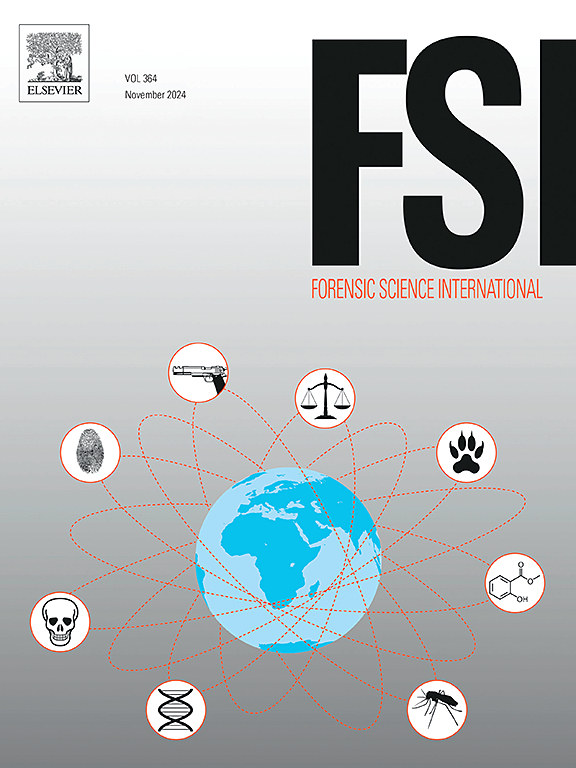一项基于英国的致命性非溺水窒息病例的回顾性研究在狗和猫
IF 2.2
3区 医学
Q1 MEDICINE, LEGAL
引用次数: 0
摘要
窒息死亡的定义是大脑和其他重要器官长期和致命的缺氧和/或缺氧。勒死、窒息、上吊、溺水、窒息、窒息和化学窒息被认为是可能发生窒息的主要形式。损伤模式的研究对于协助兽医法医专家以更高的确定性确定死因和死亡方式至关重要。对以“窒息”、“缺氧”、“缺氧”、“绞杀”、“上吊”、“窒息”、“窒息”、“窒息”为关键词的尸检病例进行回顾性研究。共有33只狗和16只猫参与了这项研究。在67 %的案件中,从发现受害者的情况来看,怀疑是窒息。掐死是狗最常见的窒息方式(25/33,76 %),而窒息或密闭禁闭在猫中更为常见(6/16,38 %)。在我们的研究队列中,一些高度指示人类窒息的发现很少甚至没有,例如外部皮肤瘀伤和舌骨骨折或脱位。多数病变局限于头颈部,包括双侧巩膜发红、脑膜充血、喉周发红、选择性皮下充血和浅表肌肉及皮下组织内瘀伤,一贯伴有严重的肺充血和水肿。然而,没有单一的病变被认为是病态的;几个病变的合并高度提示窒息。还注意到一些病变,窒息方式和受害者物种之间的重要联系。本文章由计算机程序翻译,如有差异,请以英文原文为准。
A UK-based retrospective study of fatal non-drowning asphyxia cases in dogs and cats
Death by asphyxia is defined as the prolonged and fatal deprivation of oxygen and/or blood to the brain and other vital organs. Strangulation, smothering, hanging, drowning, choking, suffocation and chemical asphyxia are considered the main modalities in which asphyxiation can occur. The study of injury patterns is crucial for assisting veterinary forensic experts in identifying the cause and manner of death with a higher degree of certainty. A retrospective study of necropsy cases identified using the keywords “asphyxia”, “anoxia”, “hypoxia”, “strangulation”, “hanging”, “choking”, “smothering” and “suffocation” was performed. A total of 33 dogs and 16 cats were included in the study. In 67 % of cases, asphyxiation was suspected from the circumstances in which the victim was found. Whereas strangulation was the most significant modality of asphyxiation in dogs (25/33, 76 %), smothering or airtight confinement were more prevalent in cats (6/16, 38 %). Some findings that are highly indicative of asphyxiation in humans were rare or even absent in our study cohort, such as external skin bruising and fracture or dislocation of the hyoid apparatus. Most lesions were confined to head and neck, including bilateral scleral reddening, meningeal congestion, circumferential laryngeal reddening, selective subcutaneous congestion and bruising within the superficial muscles and subcutaneous tissues, consistently accompanied by severe pulmonary congestion and oedema. Whereas no single lesion was considered pathognomonic; the combination of several lesions highly indicated asphyxiation. A significant association between some lesions, the modality of asphyxiation and victim’s species was also noted.
求助全文
通过发布文献求助,成功后即可免费获取论文全文。
去求助
来源期刊

Forensic science international
医学-医学:法
CiteScore
5.00
自引率
9.10%
发文量
285
审稿时长
49 days
期刊介绍:
Forensic Science International is the flagship journal in the prestigious Forensic Science International family, publishing the most innovative, cutting-edge, and influential contributions across the forensic sciences. Fields include: forensic pathology and histochemistry, chemistry, biochemistry and toxicology, biology, serology, odontology, psychiatry, anthropology, digital forensics, the physical sciences, firearms, and document examination, as well as investigations of value to public health in its broadest sense, and the important marginal area where science and medicine interact with the law.
The journal publishes:
Case Reports
Commentaries
Letters to the Editor
Original Research Papers (Regular Papers)
Rapid Communications
Review Articles
Technical Notes.
 求助内容:
求助内容: 应助结果提醒方式:
应助结果提醒方式:


